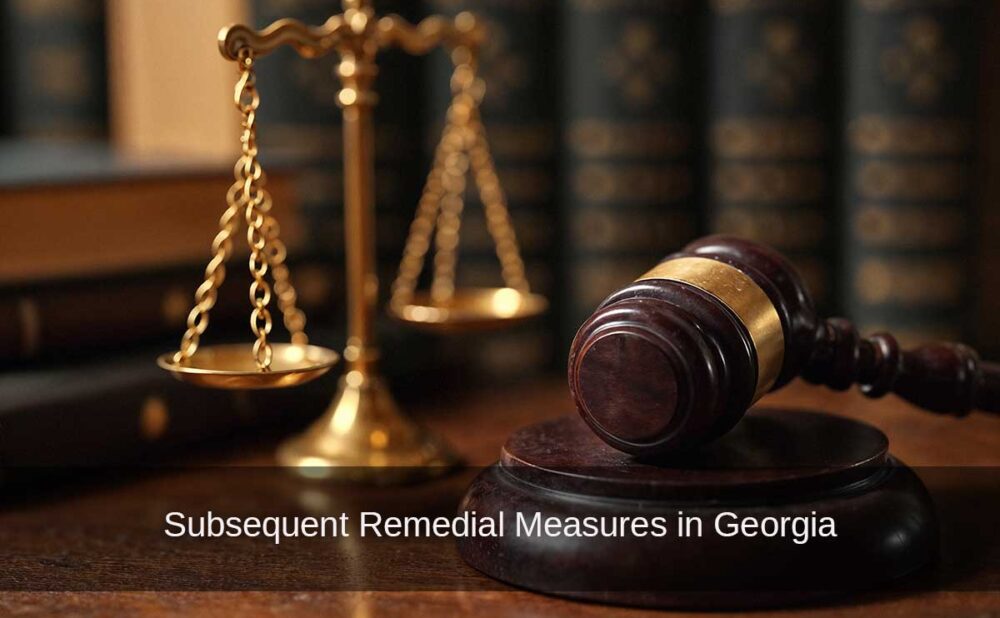Subsequent Remedial Measures in Georgia
The concept of subsequent remedial measures is a significant legal principle in tort law, particularly when addressing negligence claims and the admissibility of certain evidence in court. In Georgia, as in other jurisdictions, subsequent remedial measures refer to actions taken after an incident or accident to prevent future harm. These actions, while beneficial for public safety, can raise questions about their use in litigation. Specifically, they indicate fault, but under certain conditions, they do not prove liability. This article explores the legal framework surrounding subsequent remedial measures in Georgia, the state’s approach to these measures, and their impact on personal injury and negligence lawsuits.
What Are Subsequent Remedial Measures?
Subsequent remedial measures are actions or changes made by a defendant after an alleged incident that are intended to prevent future harm. These measures might include repairing or replacing defective products, modifying a business practice, or altering physical structures to enhance safety.
For example, if a business fixes a broken staircase after a customer falls and injures themselves, the subsequent remedial measure is the repair to the staircase. These actions are generally viewed as good practices to improve safety, yet in the context of litigation, they could suggest that the defendant acknowledged a flaw or defect that caused the original harm.
Legal Rule Against Admissibility of Subsequent Remedial Measures
In Georgia, as in many other states, the general legal rule is that evidence of subsequent remedial measures is inadmissible to prove negligence, defect, or culpability in an accident or injury. Georgia courts adopt this rule, rooted in the Federal Rules of Evidence, with some specific exceptions. The rationale behind excluding subsequent remedial measures as evidence is twofold:
- Encouraging corrective actions. Defendants might feel discouraged from making improvements that could prevent future injuries if they fear that taking remedial actions after an incident will be used against them in court. The law thus seeks to promote public safety by ensuring that the fear of liability does not deter defendants from making safety-related changes.
- Preventing unfair prejudice. Introducing subsequent remedial measures as evidence could unfairly bias a jury. A defendant who makes improvements to avoid further harm could inadvertantly acknowledge fault or liability, even if the original accident had no legal connection to the subsequent actions.
Legal Framework in Georgia
Under Georgia law, the rule about subsequent remedial measures follows the general principles set forth in the Georgia Rules of Evidence (O.C.G.A. § 24-4-407). The statute provides that evidence of subsequent remedial measures is not admissible to prove the defendant’s negligence or fault in causing the accident. However, specific exceptions may allow the admission of such evidence.
Exceptions to the General Rule
- Impeachment of Witness Testimony. If a defendant testifies in court and denies that a hazardous condition existed before the accident or denies any responsibility for the injury, subsequent remedial measures can be used to challenge the defendant’s credibility or to contradict their testimony.
- Ownership or Control. In some cases, evidence of remedial measures may be admissible to demonstrate that the defendant had control over the premises or product involved in the incident. This could be important in establishing responsibility or proving the defendant’s connection to the hazard that caused the injury.
- Other Purposes. Subsequent remedial measures can also serve purposes other than proving negligence. Such evidence can demonstrate that the defendant repaired or improved things in the normal course of business. It can also argue that another factor unrelated to the remedial measures caused the injury.
Key Georgia Cases Involving Subsequent Remedial Measures
- Campbell v. City of Atlanta (1976). This case explored the application of the rule excluding subsequent remedial measures and clarified that evidence of repairs made to a dangerous condition after an injury is generally inadmissible to prove negligence, though the trial court has discretion in certain situations.
- Harris v. Arner (1993). In this case, the Georgia Court of Appeals affirmed the principle that parties cannot introduce remedial measures taken after an incident to show that the defendant was aware of a hazardous condition before the incident.
- Georgia Power Co. v. Burch (2005). The court ruled that the defendant’s negligence could not be proven by subsequent remedial measures. The court allowed the introduction of subsequent remedial measures for limited purposes, such as demonstrating control or ownership.
Implications for Personal Injury and Negligence Cases
The rule on subsequent remedial measures has significant implications for personal injury and negligence lawsuits in Georgia. Plaintiffs and defendants must understand the limitations and exceptions to this rule when preparing their cases.
- For Plaintiffs. While plaintiffs may not be able to introduce subsequent remedial measures to directly prove negligence, they can still use other evidence to show the defendant’s fault. Plaintiffs may also challenge the credibility of defendants who deny responsibility but later take remedial actions.
- For Defendants. Defendants should be mindful that any subsequent actions, such as repairs or changes to policies, cannot be used to prove fault. However, they can use such actions to demonstrate that they are acting in good faith to prevent future harm.
In Georgia, subsequent remedial measures are an important but narrowly defined area of law. While these actions play a crucial role in improving safety and preventing future harm, they are typically inadmissible in court to establish liability in negligence cases. Understanding the legal framework surrounding these measures, including the exceptions to the rule, is essential for both plaintiffs and defendants involved in personal injury or tort cases. By promoting safety improvements without fear of legal repercussions, Georgia law strikes a balance between encouraging responsible behavior and ensuring a fair legal process.





